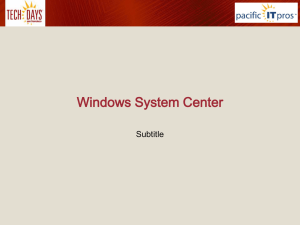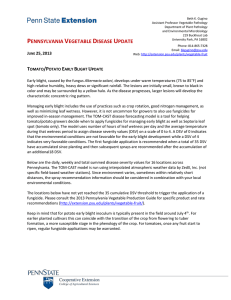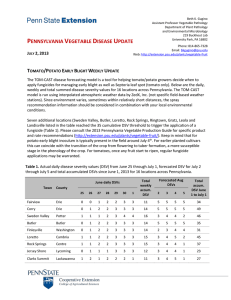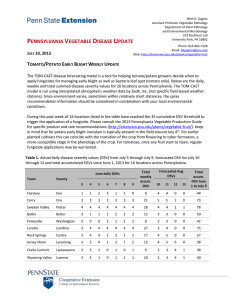Motion Correction in fMRI time series
advertisement
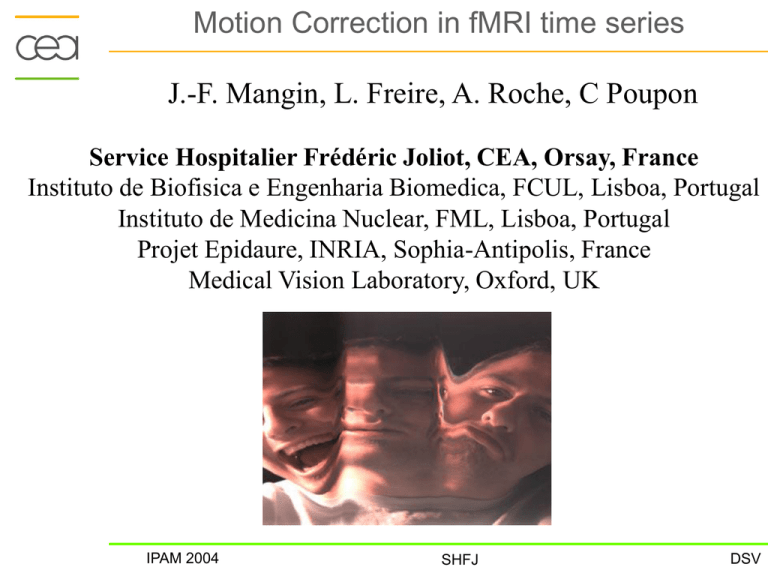
Motion Correction in fMRI time series J.-F. Mangin, L. Freire, A. Roche, C Poupon Service Hospitalier Frédéric Joliot, CEA, Orsay, France Instituto de Biofisica e Engenharia Biomedica, FCUL, Lisboa, Portugal Instituto de Medicina Nuclear, FML, Lisboa, Portugal Projet Epidaure, INRIA, Sophia-Antipolis, France Medical Vision Laboratory, Oxford, UK IPAM 2004 SHFJ DSV Motion correction, why? Taskcorrelated motion f MRI time series IPAM 2004 SHFJ voxel time series DSV Which solutions? • Some constraints in the scanner to minimize motion • Tracking (anatomical or artificial landmarks) • On line corrections (MR Echo Navigator) • Postprocessing: image registration IPAM 2004 SHFJ DSV Image registration Definition: given two images, find the geometrical transformation that « best » aligns homologous voxels First 3D image IPAM 2004 Second 3D image SHFJ DSV Classification of registration problems • Search space (rigid, non-rigid) • Monomodal / multimodal • Intra-subject / inter-subjects IPAM 2004 SHFJ DSV General formulation of image registration Given two images I et J, Optimization scheme Tˆ arg max S ( I , J , T ) Similarity measure TΤ Search space (rigid, affine, spline, etc.) IPAM 2004 SHFJ DSV Building a similarity measure Geometric Approach • Detect features (points, lines, surfaces,… graphs) • Measure the distance between these features Iconic Approach Direct comparison of intensities IPAM 2004 SHFJ DSV Intuitive example How to register these images ? IPAM 2004 SHFJ DSV Geometric/Iconic Approach Feature detection (here, points with high curvature) 2 Measure: for instance, S (T ) T (x k ) y k k IPAM 2004 SHFJ DSV Geometric/Iconic Approach Feature detection (here, points with high curvature) 2 Measure: for instance, S (T ) T (x k ) y k k IPAM 2004 SHFJ DSV Geometric/Iconic Approach No segmentation! S (T ) (ik jk ) 2 Measure: e.g., Interpolation: jk J (T (x k )) k T jk T (x k ) IPAM 2004 ik xk SHFJ DSV Geometric/Iconic Approach The simple case of binary images… No segmentation! S (T ) (ik jk ) 2 Measure: e.g., k T1 =Id IPAM 2004 SHFJ DSV Geometric/Iconic Approach No segmentation! S (T ) (ik jk ) 2 Measure: e.g., Partial overlap k T2 IPAM 2004 SHFJ DSV Iconic approach for fMRI! A lot of widely used softwares: SPM, AIR, AFNI, etc. Minimize the sum of squared differences A typical fMRI image of the nineties IPAM 2004 Search through rigid motions (sometimes affine) SHFJ DSV Main differences between softwares? •Preprocessing (smoothing) •Interpolation nearest neighbor spline linear •Optimization scheme (iterative) •Powell •Levenberg Marquardt •Modified Gauss-Newton IPAM 2004 Fighting with local optima Improving accuracy SHFJ DSV Iterative optimization of smooth measure Small motion = good initialization IPAM 2004 SHFJ DSV Is everything fine? Block design, 3T magnet Activations? 18 frames (2 sec/frame) versus 180 frames t Motion correction IPAM 2004 SHFJ DSV The consequences of motions Motion-related artifacts: – intrascan motion; – the spin history effect; – interaction between motion and susceptibility; – Non perfect estimation and interpolation. Task-correlated motion = Confounds in cognitive analysis Use motion estimations as regressors? IPAM 2004 SHFJ DSV BUT! Could activated areas be responsible For the task-correlated motion estimation? Is this monomodal situation so secure? IPAM 2004 SHFJ DSV Assumed relationship: Conservation of intensity Intensities of image I Classification of standard similarity measures Intensies of image J Adapted measures : Sum of squared differences Sum of absolute differences IPAM 2004 SHFJ DSV Classification of standard similarity measures Intensities of image I Assumed relationship: Affine Intensies of image J Adapted measures Correlation coefficient IJ (T ) 1 n I J ( i I )( j k k J ) k 1 Ratio of image uniformity (Woods) R N i Rm 2 i Rm IPAM 2004 SHFJ DSV Classification of standard similarity measures Functional Intensities of image I Assumed relationship: Intensies of image J Adapted measures Woods criterion (1993) Woods variants (Ardekani, 95; Alpert, 96; Nikou, 97) Correlation Ratio (Roche, 98) IPAM 2004 SHFJ DSV Classification of standard similarity measures Statistical Intensities of image I Assumed relationship: Intensies of image J Adapted measures Joint entropy (Hill, 95; Collignon, 95) Mutual Information (Collignon, 95; Viola, 95) Normalized Mutual Information (Studholme, 98) IPAM 2004 SHFJ DSV Do activated areas bias Least Square approaches? II. Methods Similarity Measures • • • • • • IPMI’01 Let us compare various methods… LS-SPM (Friston); LS-AIR (Woods); GM - custom (INRIAlign); RIU-AIR (Woods); CR – custom (Roche) MI - custom (Wells, Maes, Viola). Confounds related to interpolation method or search method ? The “sum of squared differences” measure assumes Gaussian noise for the difference between both images… In some experiments • LS - Custom; • RIU - Custom; IPAM 2004 SHFJ DSV Entropy for Image Registration Define a joint probability distribution: – Generate a 2-D histogram where each axis is the number of possible greyscale values in each image – Each histogram cell is incremented each time a pair (I_1(x,y), I_2(x,y)) occurs in the pair of images • If the images are perfectly aligned then the histogram is highly focused. As the images mis-align the dispersion grows • recall Entropy is a measure of histogram dispersion IPAM 2004 SHFJ DSV Using joint entropy for Image Registration – Define joint entropy to be: H ( A, B) p(i, j ) log[ p (i, j )] i, j – Images are registered when one is transformed relative to the other to minimize the joint entropy – The dispersion in the joint histogram is thus minimized IPAM 2004 SHFJ DSV Definitions of Mutual Information Commonly used definitions: I(A,B) = H(A) + H(B) - H(A,B) Maximizing the mutual info is equivalent to minimizing the joint entropy (last term) p ( a, b) I ( A, B) p(a, b) log a ,b p(a) p(b) This definition is related to the Kullback-Leibler distance between two distributions IPAM 2004 SHFJ DSV This is not a robustness or accuracy study ! IPMI’01 Aim of the comparison of methods: – assess the potential bias in motion parameter estimation due to activation presence, whatever the actual accuracy of each method. Accuracy study has been done in several works (Jiang, Frouin, West, Holden, etc.), and requires the study and optimization of each parameter influence, which is far beyond the scope of this work. IPAM 2004 SHFJ DSV II. Methods Image Acquisition A few words about the datasets IPMI’01 – Brucker scanner operating at 3T using a 30 contiguous slice 2D EPI sequence (slice array of 64x64 voxels). – Pixel size of 3.75mm and slice thickness of 4mm. – Various simulated time series. – Actual time series using a block design. IPAM 2004 SHFJ DSV Simulated Activation Patterns IPMI’01 A first pattern inferred from a simple visual experiment Two smaller patterns stemming from erosion of the initial largest pattern Pattern Size (%) Mean(%) Max(%) IPAM 2004 A1 12.4 1.26 2.04 A2 6.2 1.19 2.03 A3 3.2 1.18 2.03 SHFJ DSV Design of Simulated Time Series IPMI’01 3x3x3 median filtering Tsim applied. 62x62x28 geometry. Gaussian/Rician noise ( = 2.5%) Activation pattern IPAM 2004 Reference image 1 SHFJ Test images 2 n DSV I Simulated Activations Without Motion + 0 x 1 2 Test,1 Test,2 39 40 3-D Frames Test,39 Run the six registration methods and evaluate the transformation parameters (tx, ty, tz, rx, ry, rz) for each package. Compute cross-correlation between each parameter and A1 time course and infer activated areas. IPAM 2004 SHFJ DSV A couple of estimated motion parameters IPAM 2004 SHFJ I DSV Detection of “activated areas” using General Linear Model I Spatial Gaussian smoothing - 5mm Low-pass filtering with 2-frame width Voxels activated if p-value > 0.001 Spurious Clustered Voxels (false positives) LS-SPM – 227 LS-AIR –16 RIU-AIR and MI - 0 IPAM 2004 SHFJ DSV Simulated activations with simulated motion IPMI’01 II 1 2 20 1 2 20 1 2 20 t=0.1mm Tsim t=5.0mm r=0.1deg r=2.0deg t = 0.1, 0.2, 0.5, 1.0, 2.0 and 5.0 mm r = 0.1, 0.2, 0.5, 1.0, and 2.0 deg IPAM 2004 SHFJ DSV Simulated activations with simulated motion Nº 1 2 3 4 5 6 7 8 II 8 Different Reference Images Pattern Mean Signal Increase (%) NA NA A1 0.63 A1 1.26 A1 2.52 A1 5.04 A1 10.08 A2 2.52 A3 2.52 IPAM 2004 SHFJ DSV Simulated activations with simulated motion IIA IPMI’01 Influence of motion amplitude - 2 Reference images: 1 2 3 4 5 6 7 8 Pattern NA A1 A1 A1 A1 A1 A2 A3 Mean Signal Increase (%) NA 0.63 1.26 2.52 5.04 10.08 2.52 2.52 - Test images: t = 0.1, 0.2, 0.5, 1.0, 2.0, 5.0 mm. r = 0.1, 0.2, 0.5, 1.0, 2.0 deg. IPAM 2004 SHFJ DSV Simulated activations with simulated motion IPAM 2004 SHFJ IIA DSV Simulated activations with simulated motion IPAM 2004 SHFJ IIA DSV Simulated activations with simulated motion IIB IPMI’01 Influence of activation amplitude - 6 Reference images: Pattern NA A1 A1 A1 A1 A1 A2 A3 1 2 3 4 5 6 7 8 Mean Signal Increase (%) NA 0.63 1.26 2.52 5.04 10.08 2.52 2.52 - Test images: t = 0.2 mm. r = 0.2 deg. IPAM 2004 SHFJ DSV Simulated activations with simulated motion IPAM 2004 SHFJ IIB DSV Simulated activations with simulated motion IPAM 2004 SHFJ IIB DSV Simulated activations with simulated motion IIC IPMI’01 Influence of activation size - 4 Reference images: Pattern NA A1 A1 A1 A1 A1 A2 A3 1 2 3 4 5 6 7 8 Mean Signal Increase (%) NA 0.63 1.26 2.52 5.04 10.08 2.52 2.52 - Test images: t = 0.2 mm. r = 0.2 deg. IPAM 2004 SHFJ DSV Simulated activations with simulated motion IPAM 2004 SHFJ IIC DSV Simulated activations with simulated motion IPAM 2004 SHFJ IIC DSV Evaluation of spatial filtering pre-processing effect III IPMI’01 – We have also performed an additional experiment on the influence of the initial spatial smoothing applied by SPM and AIR – RIU-AIR problems are overcome by a large smoothing, but motion estimates turn out to be biased. – For SPM, low smoothing implies smaller bias but motion estimates are less accurate. IPAM 2004 SHFJ DSV III IPAM 2004 SHFJ DSV IV Experiment With Actual Time Series IPMI’01 18 frames (2 sec/frame) 180 frames IPAM 2004 t SHFJ DSV IPAM 2004 SHFJ DSV Experiment With Actual Time Series IV Statistical Inference: Gaussian smoothing (FWHM 5mm); High-pass temporal filtering (period 120s); Low-pass temporal filtering by a Gaussian function (4s). Two explanatory variables: Periodic stimulus convolved with a standard hemodynamic response; Time derivative of hemodynamic response. Voxels reported activated if the p-value > 0.05. IPAM 2004 SHFJ DSV Experiment With Actual Time Series: “activations” IPAM 2004 SHFJ DSV Activations can bias “sum of squares” measure IV. Discussion “Robust” similarity measures have been classicaly used in multimodality registration studies. In monomodality studies, when the residuals are endowed with a Gaussian distribution, LS-based methods are optimal estimators. The experiments presented in this work prove that the use of LS-based methods for functional studies may be questioned, due to the presence of activated areas. IPAM 2004 SHFJ DSV Measure comparison, first simulation – In first simulation, the use of the LS-custom method shows that the bias in LS-based similarity measures is related to the nature of the measure and not to the intrinsic computational implementation of each method. – The bias may induce spurious activations along highcontrast brain edges, in the absence of subject motion. – RIU-AIR and MI are more robust to activation presence, but presented qualitatively different results. Accuracy vs. Robustness. IPAM 2004 SHFJ DSV Measure comparison, other simulations – The second set of simulations indicates that RIU-AIR and MI accuracy does not depend on the presence of activations. – Also that the bias magnitude is highly related to the signal change amplitude. This may explain why our 3T magnet led to more difficulties than more usual 1.5T scanners. Indeed, it can be seen that activation level has a more dramatic role on the accuracy decline than activation size. IPAM 2004 SHFJ DSV Actual time series – The experiment with actual time series seems to be consistent with our interpretation of the simulation studies. – LS-SPM and LS-AIR give different results, particularly in pitch. The other two methods do not detect this putative motion. – Yaw estimations obtained by the four methods do not agree. This may be related to distortions that cannot be corrected with rigid-body transformations. IPAM 2004 SHFJ DSV Spurious activations – LS-based methods create spurious clusters of activated voxels, whose localization depends, in our opinion, on the brain edge orientation relatively to actual activation localization. – Spurious activations may appear at the same place across individuals and survive to group analysis – While we hope that this alarming prediction is too pessimistic, it calls for trying to minimize the risk. IPAM 2004 SHFJ DSV V. Conclusion So what? IPMI’01 – Our work has shown that “robust” similarity measures could improve the situation with activation-based outliers – MI was used for historical reasons, but it may not be the best choice. MI is prone to local maxima problems. – Could we build a dedicated robust similarity measure? IPAM 2004 SHFJ DSV Mutual Information weaknesses (Pluim, Tsao) Estimation of the joint histogram (Parzen windows…) Number of bins Interpolation method IPAM 2004 SHFJ DSV Which similarity measures? Taxonomy S. Measure Expression Intensity Conservation Least-squares (LS) Least-squares with a GM estimator (GM) Affine Dependence Ratio of Image Uniformity (RIU) Functional Dependence Correlation Ratio (CR) Statistical Mutual Information Dependence (MI) IPAM 2004 SHFJ pab a b 2 a b 2 a b pab 1 a b2 / c 2 a b 1 N R i Rm 2 i Rm 1 1 A2 p b 2 B b pab pab log pa pb a b DSV The influence of the cut-off parameter in GM Back to first simulation… In the GM expression: 2 a b pab 2 a b a b 1 c2 one shall tune the value of c. However, the robustness against “outliers” may lead to local optima problems. IPAM 2004 SHFJ DSV The influence of spatial smoothing GM with no smoothing leads to many local minima problems, thus smoothing is required. In return, the CR and CRsym methods turn out to be more biased as the smoothing level increases. IPAM 2004 SHFJ DSV Simulated motionless time series. IPAM 2004 SHFJ DSV The actual time series IPAM 2004 SHFJ DSV Discussion - MI and GM methods seem to be the most robust methods relatively to activation presence. - The GM has a disadvantage, which is related to the tuning of the c parameter. A dynamic strategy to perform this tuning could eventually lead to better results. - However, some correlations with the activation task persist. - Build new dedicated measure after activation detection? IPAM 2004 SHFJ DSV Let us try this simple idea with a couple of measures • • • • • LS – Custom (Friston et al., 1996); GM – Custom (Nikou et al., 1998); RIU – Custom (Woods et al., 1992); CR – Custom (Roche et al., 1998); MI – Custom (Collignon et al. 1995, Wells et al., 1996). Similarity measures implemented according to the conventional (1) and the proposed approach (2), which discards the activation signal. IPAM 2004 SHFJ DSV Discarding the Activated areas reference Mask IPAM 2004 test images LS(1) RLS(1) RIU(1) CR(1) MI(1) LS(2) RLS(2) RIU(2) CR(2) MI(2) SHFJ DSV Results (first simulation) tx ty tz rx ry rz LS 1 0.09 0.84 0.84 0.79 0.04 0.25 IPAM 2004 LS 2 0.01 0.38 0.16 0.17 0.17 0.13 GM 1 0.06 0.45 0.49 0.03 0.28 0.13 Simulation without motion GM 2 RIU 1 RIU 2 0.07 0.07 0.14 0.12 0.82 0.32 0.12 0.79 0.04 0.01 0.79 0.24 0.21 0.19 0.05 0.20 0.22 0.29 SHFJ CR 1 0.20 0.34 0.18 0.07 0.05 0.10 CR 2 0.05 0.03 0.40 0.03 0.13 0.06 MI 1 0.04 0.40 0.25 0.23 0.03 0.07 MI 2 0.33 0.05 0.09 0.28 0.16 0.01 DSV Results (actual time series) IPAM 2004 SHFJ DSV Results (3 actual time series) tx ty tz rx ry rz LS 1 0.27 0.65 0.46 0.72 0.02 0.01 LS 2 0.27 0.17 0.14 0.10 0.05 0.13 GM 1 0.14 0.32 0.16 0.35 0.14 0.18 GM 2 0.13 0.12 0.34 0.03 0.09 0.15 tx ty tz rx ry rz LS 1 0.17 0.57 0.63 0.72 0.05 0.20 LS 2 0.24 0.27 0.29 0.37 0.16 0.03 GM 1 0.03 0.45 0.27 0.53 0.12 0.03 GM 2 0.02 0.18 0.02 0.26 0.04 0.02 tx ty tz rx ry rz LS 1 0.36 0.67 0.64 0.69 0.01 0.38 LS 2 0.40 0.29 0.11 0.05 0.04 0.17 GM 1 0.03 0.51 0.33 0.44 0.06 0.13 GM 2 0.15 0.17 0.03 0.01 0.03 0.09 IPAM 2004 SET 1 RIU 1 0.29 0.64 0.17 0.74 0.07 0.13 SET 2 RIU 1 0.20 0.58 0.45 0.73 0.21 0.03 SET 3 RIU 1 0.36 0.62 0.46 0.68 0.10 0.29 RIU 2 0.23 0.12 0.25 0.13 0.07 0.18 CR 1 0.04 0.27 0.12 0.36 0.06 0.07 CR 2 0.05 0.01 0.27 0.01 0.03 0.13 MI 1 0.02 0.41 0.19 0.58 0.14 0.18 MI 2 0.14 0.06 0.42 0.06 0.07 0.01 RIU 2 0.30 0.18 0.19 0.33 0.20 0.07 CR 1 0.13 0.25 0.11 0.41 0.01 0.01 CR 2 0.01 0.09 0.15 0.02 0.02 0.18 MI 1 0.01 0.34 0.17 0.57 0.10 0.08 MI 2 0.02 0.04 0.05 0.15 0.20 0.06 RIU 2 0.41 0.22 0.04 0.14 0.02 0.22 CR 1 0.03 0.17 0.33 0.23 0.04 0.12 CR 2 0.09 0.08 0.06 0.08 0.15 0.19 MI 1 0.29 0.32 0.23 0.40 0.07 0.08 MI 2 0.21 0.07 0.10 0.13 0.01 0.06 SHFJ DSV Results (2 actual time series, activations) IPAM 2004 SHFJ DSV Discussion - This last work rules out the hypothesis of a true taskrelated motion. Indeed, discarding about 20% of the voxels almost removes the correlation with the task. - The dilation of the mask is fundamental in order to avoid contamination of neighbor voxels by activated voxels - The proposed strategy is easy to implement and suitable for most conventional studies. Improvements may be required when registering complex studies. IPAM 2004 SHFJ DSV General Conclusions & Further Work Be careful! - We have shown that the problem of registration of fMRI time series should be revised in order to take into account the influence of activation. - We will have to study situations including true taskcorrelated motion. - Detecting motion and activation simultaneously ?(Orchard et al., 2003). - Interactions between motion and distortions! IPAM 2004 SHFJ DSV Eddy-Current Distortion Correction for MR Diffusion Imaging + IPAM 2004 SHFJ DSV Diffusion tensor imaging Diffusion-weighted signal attenuation: Tensor estimation: Several gradient directions ( at least 6) One gradient chronogram = One b matrix D <x2>1/2 17 50 Chronogram IPAM 2004 50 SHFJ Td Several gradient strengths and durations DSV Eddy current related EPI distortions Spatial resolution :1,875 mm x 1,875 mm x 2,8 mm Diffusion-sensitizing gradient related distortion Gradient 0 mT/m No gradient Scaling Translation Shearing Gradient 22 mT/m 8 mm IPAM 2004 SHFJ DSV Slice by slice estimation of affine transformations Mutual information landscape Powell algorithm Maximum T1 Parzen window = truncated gaussian Linear resampling grey value coded with 6 bits T0 S T1 Mutual information maximization IPAM 2004 SHFJ DSV Results for one slice Higher variability with CR than with MI 128 x 128 2mm x 2mm Reference: T2-weighted 4 repetitions X gradient: shearing (frequency) Y gradient: shrinking (phase) Diffusion gradients: 6 directions 5 amplitudes 4 repetitions Z gradient: translation (T0) (slice) IPAM 2004 SHFJ DSV Improvements achieved by the new estimation scheme T2-weighted Fractional anisotropy Fractional anisotropy without corrections with the corrections Fractional anisotropy = variability of the tensor eigenvalues IPAM 2004 SHFJ DSV That’s all A SPM plug-in performing fMRI motion correction using the Geman McClure robust estimator is freely distributed by the Epidaure group (INRIA) INRIAlign… IPAM 2004 SHFJ DSV
